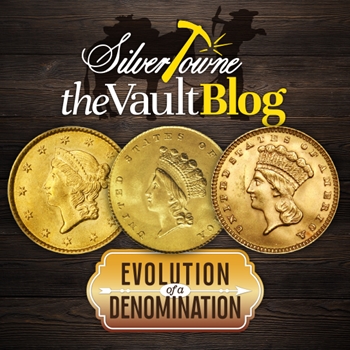
The beginning of government issued gold coins in the United States stemmed from a small, privately owned minting operation by a German immigrant who owned a jewelry shop in North Carolina in the 1830s. Advertising the production of gold coins from gold dust and nuggets, the shop owner would turn out more than $2.2 million worth of gold coins by 1840. Around half of these were gold dollars. While the operation was legal, Uncle Sam would monitor the family’s private minting of these coins and eventually aim to do the same. Congress would authorize such in 1836, but the Director of the United States Mint would object the idea and thus the first gold dollars were not produced until the late 1840s.
Liberty Head (1849-1854)
While gold coins were not at the top of the priority list in the 1830s and much of the 1840s, the government would change their tune as the gold rush in California would light the match to an already discovered gold mine at Sutter’s Mill in 1848. While the Director of the Mint, Robert M. Patterson, would continue his objection to the coinage, it would still move forward. On March 3, 1849, Congress authorized legislation for gold dollars and double eagles ($20 gold pieces).
Chief Engraver of the Mint, James Barton Longacre, was chosen to design both new gold coins. A left-facing Liberty with a coronet in her hair was on the obverse, encircled by 13 stars to represent the 13 colonies. The reverse features the denomination and the date with a wreath, encircled by the inscription “UNITED STATES OF AMERICA.” From this design came a few different varieties, including Open and Closed Wreath in that first year of production in 1849. They were struck at Philadelphia, Charlotte, Dahlonega, New Orleans, and San Francisco with the highest mintages coming from Philadelphia. The Liberty Head design would be known as the Type 1 of the gold dollars and remained until 1854.
One of the most unique details about this coin was the fact that it was less than three-quarters the size of a dime today. It seems as if the biggest gripe about coins back during those times and the times to follow was how big coins were, how large and how heavy they were to carry around. This was certainly not the case for this coin as they were easily misplaced despite their purchasing power. Today they are rare and a major find for collectors if they can get their hands on one.
Indian Princess Head, Small Head (1854-1856)
Despite their unique size and contrasting value, objections were made against the gold dollar being so small. The Mint would eventually respond and over the course of a few years would test strikes and possible substitutes that were larger but had holes in the center to make sure their weight stayed the same. However, with a new Mint Director at the helm, the hole in the center became an idea of the past as the drive to keep the weight the same but the coin larger was simplified with making it thinner. Longacre again was tasked with not only making the changes, but also coming up with a different design.
Modeled after the three-dollar gold piece, the obverse of the new gold dollar featured a left-facing female wearing a fancy headdress. Often described as an “Indian Princess,” the coin is also referred to as an Indian Head type. While the coin was larger, difficulties did arise during the striking process. Longacre had made the relief too high on the obverse and the majority of coins were less than fully struck. These coins were struck at all five of the branches as the previous gold dollar with the most coming from Philadelphia. This type, referred to as Type 2, was only struck for two short years due to complications.
Indian Princess Head, Large Head (1856-1889)
Longacre was once again tasked at returning to the drawing board as the determination to create the right gold dollar was fierce. When it came to the design, he made the portrait larger and flatter but the design itself is essentially the same as the Type 2. While the series did see coins struck in various years at Philadelphia, Charlotte, Dahlonega, and San Francisco, most of the gold coins minted came from Philadelphia.
Source: NGC Coin; The Official 2024 Red Book







